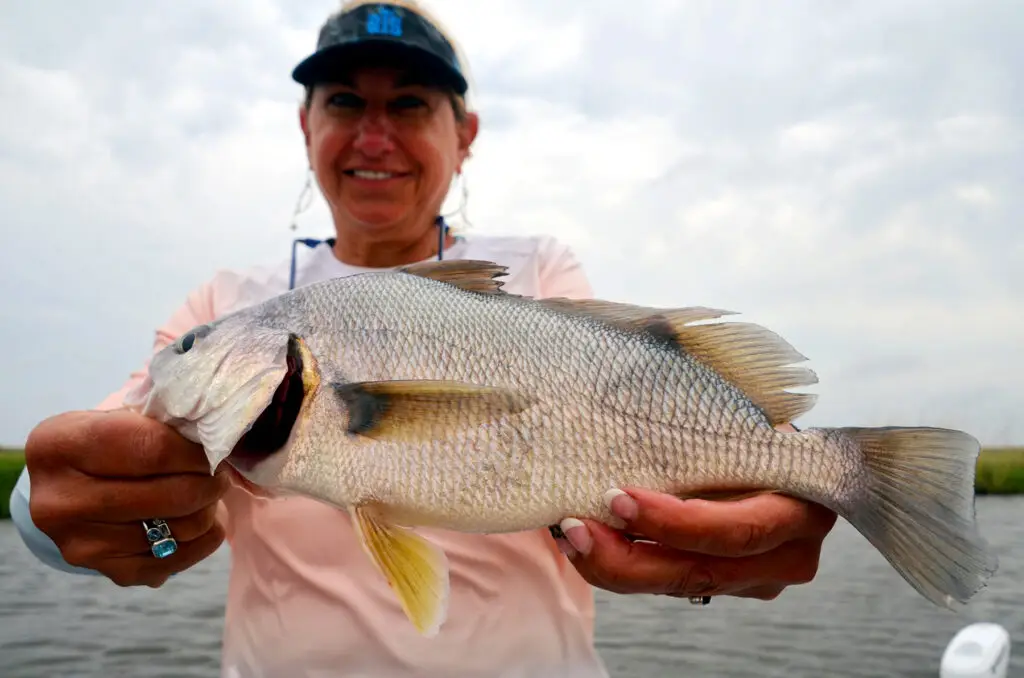Drifting along the Tennessee River, we dropped down live shad to tempt the legendary trophy smallmouth bass living in these waters.
As the sinker bounced along the bottom, the reel started screeching. Something huge grabbed the struggling shad 15 feet below us. After quite a vigorous fight on light tackle, a massive image materialized just beneath the surface, something far larger than the current Alabama state record smallmouth of 10.50 pounds.
Not finished yet, the large fish swooshed its tail and headed straight for the bottom again. Eventually, we subdued the 18-pound sand-colored fish with a white belly and a down-turned mouth designed for slurping morsels off the bottom.
Landing several fish in the 20- to 25-pound range, I didn’t even come close to breaking the state record for this species, which sits at 41.80 pounds. That fish also came from the Tennessee River. While I didn’t break the coveted smallmouth record, the giant fish and dozens of its cousins provided incredible rod-bending action, even if my guide didn’t appreciate the catch.
Among the most widespread, abundant and largely ignored fish in North America, freshwater drum can exceed 50 pounds. The only member of the drum family to exclusively inhabit freshwater systems, these powerhouses occur in most major rivers and reservoirs in Alabama.
“Freshwater drum are very common in Alabama,” says Tommy Purcell, the District Fisheries Supervisor for the Alabama Wildlife and Freshwater Fisheries office in Spanish Fort. “They occur in the Tennessee River and throughout the Mobile Basin, except above Lake Martin on the Tallapoosa River. Freshwater drum are in the same family as speckled trout, redfish and croaker. Some Great Lakes anglers call this species sheepshead and target them.”

These powerful fish generally like clean, flowing water with moderate current, but anglers also find them in backwaters and oxbow lakes. Drum can tolerate turbid or murky conditions, but favor sand or gravel bottoms to mud. They usually like to stay around hard structures, like rockpiles or bridge pilings in open water rather than lurk in the weeds like a largemouth. Anglers routinely spot drum swimming near dams and other structures or hear them slurping shad next to the concrete.
“Drum can be found in a variety of habitats, but they especially like large rivers, lakes, pools and reservoirs,” Purcell says. “Small drum eat a lot of aquatic insect larvae. Larger ones mostly eat mollusks, especially mussels and clams. They also like fish, such as gizzard and threadfin shad.”
While few Alabama anglers intentionally fish for drum, many catch them by accident. Bass fishermen catch drum on various lures. Crappie and catfish anglers using natural baits like minnows, crawfish or nightcrawlers regularly catch them. Drum even hit crappie jigs. A live threadfin shad fished on a Carolina rig or a free line can prove too tempting for most drum to resist. Once on the hook, these scrappy, formidable fighters put on quite a show like their salty cousins, redfish and black drum.
“Drum are a lot of fun to catch,” Purcell says. “The best places to target them in Alabama are on the large rivers. Fish the downstream side of dams drifting live shad with the current. Anglers targeting catfish also catch them on cut bait, crawfish and live worms.”
Although drum typically prefer natural baits, they sometimes hit lures. With small, downward-facing mouths, these bottom feeders can’t attack big bulky baits that anglers might throw for lunker largemouths, but drum could suck down anything that resembles a small fish or crawfish. Drum mostly like soft baits, such as plastic grubs, worms, tubes, swimbaits and craw-style baits, especially scented ones. They might hit spinnerbaits, spoons, crankbaits and other lures. They sometimes hit fly tackle.
Freshwater drum probably garnered their poor standing among sport fishermen because of their unsavory table reputation. Much of the flavor of these bottom feeders depends upon their environment. If it came from clean, cold water with a hard sandy or rocky bottom and prepared by a good chef, it might taste like its salty cousins. If it came out of muddy water with a mucky bottom, that’s probably what it would taste like. Regardless, they always put on a strong, spirited fight.
On a slow day, like the one I described when we didn’t even see a smallmouth, these fish can turn a goose egg into a wonderful memory, especially for youngsters. Imagine the smile on a child’s face after fighting a double-digit river donkey on light tackle!
John N. Felsher is a professional freelance writer who lives in Semmes, Ala. He also hosts an outdoors tips show for WAVH FM Talk 106.5 radio station in Mobile, Ala. Contact him at [email protected] or through Facebook.




